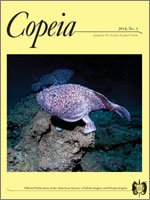The lower jaw of Lepisosteus osseus has been described as containing a U-shaped cartilaginous structure identified as a detached portion of Meckel's cartilage. We investigated this structure through study of a growth series of L. osseus, including cleared-and-stained specimens and histological preparations. Meckel's cartilage is well developed by 17.2 mm SL, and is formed by typical hyaline cartilage. The left and right Meckel's cartilage are continuous across the anterior midline in most small specimens (<35 mm SL), although the robustness of this continuity is variable and in some specimens the two sides are separate. In larger individuals (>85 mm SL) the left and right sides are separate from one another and end far posterior to the tip of the dentaries. In specimens between 17.6–22.1 mm SL, there is a diffuse, V-shaped patch of connective tissue between the rami of the lower jaws. By 35 mm SL this patch becomes more consolidated and in histological sections of a 44.6 mm SL specimen, it is revealed to contain chondrocytes. In even larger individuals, this becomes a well-defined U-shaped structure. Because both this structure and a Meckel's cartilage that crosses the anterior midline are present in the same individuals, we conclude that this cartilage is not homologous to the anterior portion of Meckel's cartilage (i.e., it fails the test of conjunction) but is rather a neomorphic structure, herein termed the rostrohyal.
How to translate text using browser tools
1 March 2014
Identity of a Unique Cartilage in the Buccal Cavity of Gars (Neopterygii: Lepisosteiformes: Lepisosteidae)
Eric J. Hilton,
Peter Konstantinidis,
Nalani K. Schnell,
Casey B. Dillman
ACCESS THE FULL ARTICLE





